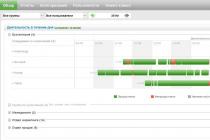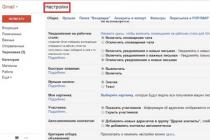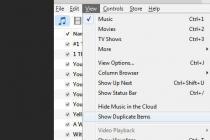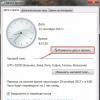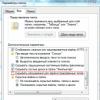A few years ago, 1 GB of memory was enough for many iPhone owners. But today everything has changed. The software began to weigh more, so the device's memory fills up very quickly. In addition, there are more and more interesting applications, each of which you want to have on your phone.
When there is not enough memory, the user thinks about how to clear the cache on the iPhone. This article contains tips on how to free up space on iPhone 4, 4S, iPhone 5S, iPhone 6 and other gadgets.
If you are confused about how to free up space on iPhone, uninstall extra programs... It is very easy to delete data in this way from an iPhone 4 or any other model of an "apple" phone. Perhaps, this method is the most simple, but effective removal.
But before you release the cache, carefully review the list installed programs... Of these, select those that are rarely used - for example, no more than once every six months. You will have to clear the iPhone just from these programs, since they are not the most necessary and useful. But if in the future any erased program is needed, it can be easily restored from the cloud, like documents and data.
How to clear the cache on an iPhone by reinstalling software
Any iPhone owner over time notices that familiar programs have begun to take up too much space in the device's memory. And usually this applies to instant messengers, social network clients and the like. And the reason for that is data caching.
Due to caching, the memory on the iPhone becomes clogged faster. And the user is faced with the question of how to clean the iPhone from garbage. There are many programs that can clear the cache on an iPhone. Of course, you can take advantage of them. But there is an easier way to clear the cache. You just need to reinstall the application from the very beginning.
How to clean iPhone memory with Battery Doctor
Despite the name of the utility, it does more than provide information about the battery. It also helps to clean iPhone from all junk. So if you are concerned about how to clean your iPhone and how to remove useless software, take this program into your arsenal.
Clearing the cache in this program is possible in the Junk section. Here you can also erase temporary files of programs and applications. The disk space will expand significantly.
In addition, the named program is capable of cleaning RAM... This is done through a widget or using an icon. quick launch... All this will be extremely useful for gamers.
How to free up memory by customizing the export of photos and videos
Every year Apple improves the cameras of its phones, however, as well as all other elements. On the one hand, this is a plus. But on the other hand, the volume of user photos that need to be stored somewhere is also increasing.
There is no other way to solve this problem, except for storing photos on a PC or laptop, as well as in the cloud. And if your photos are already running out of space in iCloud, and you don't want to purchase additional ones, try Google unlimited storage.
Clearing iPhone memory by getting rid of music
When the Apple Music application appeared, there was no need to store music in the memory of the gadget. However, many users want to keep local access to their favorite tracks. Indeed, in the absence of the Internet or problems with the network, listening to music will not work. But here you just need to approach the problem sensibly and download a limited number of tracks to the device.
Disable automatic podcast updates
Podcasts take up a decent amount of storage space on your iPhone. And, as many people know, when the eighth version of iOS came out, the software for their wiretapping became an integral part of the "operating system".
If you don’t really need podcasts and you don’t always listen to them, turn off the automatic download of new items. In addition, activate the function for deleting episodes that have been listened to.
Delete messages to clear the cache
It's hard to believe, but simple text SMS messages can accumulate in such a large amount that over time they will clog up your memory. After a few years of using an iPhone, they can take up gigabytes of space. This is especially true of instant messengers, through which the user sends his friends, in addition to text, also photos, videos, and so on.
Clearing browser data
As you know, absolutely all browsers store cache and many other data. AND mobile browser Safari is no exception. Therefore, a very useful habit for every iPhone owner will be to regularly enter the Safari settings and delete history and data.
Reset and restore methods for clearing the cache
In the end, let's talk about the most dreary, but very effective method. Complete cleaning device memory and resetting its settings will return the gadget to original state... But, the saddest thing is that the user will lose all information. Therefore, before starting the operation, you need to make a backup in iTunes or iCloud.
After careful preparation, follow these steps:
- Go to the main settings of the gadget.
- Go to the reset section.
- Click on the button that is supposed to erase all content and settings.
- Restore the device from backup (or better, set it up as a new one, and then download all applications again).
We use all the features of iOS
To save iPhone memory, you can also use the following recommendations:
- Turn off Enhanced VoiceOver.
- Turn Siri on and off several times to clear the cache.
- Turn off iCloud data sharing for unnecessary information.
- Disable photo stream.
- Turn off unnecessary applications in Spotlight.
- Erase or rebuild "accounts" in mailers.
- Disable the user's dictionary.
- Do not save photos or other content in your messages.
- Turn off albums with recently erased photos.
- Turn off the option to store original photos and videos on your gadget.
- Disable background refresh mode for as many applications as possible.
- Shoot video footage in FullHD, not 4K.
- Get rid of languages installed on the system that you do not need.
- Synchronize with iTunes utility.
All of the above tips will help you not to clog your cache with unnecessary information. This way you will save your iPhone's memory and be able to install tons of really useful applications.
Though modern smartphones iPhone and iPad tablets have a large amount of permanent memory, sooner or later, but most of their owners are faced with a lack of free space on the device. It is especially offensive when you need to download or save something very important on your phone, and here, as luck would have it, the iPhone writes "There is almost no space."
What to do in this case? The answer is simple - delete the unnecessary. Many users inadvertently throw themselves "all bad", deleting everything. Often this ends in tears because you can get caught under the hot hand system files or just something important to you.
In this article, I want to tell you how to free up memory on an iPhone without the risk of deleting something you need or even disabling it. operating system on your iPhone and iPad.
1. Total cleaning of the Safari browser
The very first thing to start with liberation iPhone memory Is a web browser. In some cases, it inflates like a balloon.
Let's start by clearing the Safari cache, cookies and deleting temporary files. To do this, go to the settings of the mobile gadget and find the section Safari:
Once in, we find the item Clear history and site data.
After that, go to the section "Additional" >> "Data" sites:
We click on the "Delete all data" button in order to delete all the saved information about the sites and thereby at least a little, but free up memory on the iPhone.
Do not forget about the separate "Offline List" function, which serves for deferred reading of pages in Safari and thus also takes up space in the ROM. Moreover, sometimes the volume occupied for this can reach a gigabyte and even more.
To clear it, go to Settings >> General >> Statistics >> Repositories >> Safari. Here you need to tap on the "Delete" button to completely remove the entire offline list. Note that clearing the cache will not remove objects from the Reading List.
2. Search for unnecessary applications
Those who are fond of various games on a mobile phone or tablet, the memory is often crammed with old games that have not been used for a long time, and they forgot to delete them. To fix this and clear up free space on iPhone and iPad - open "Settings" >> "General" >> "Statistics" >> "Storage":
Here you will see a list of applications sorted according to memory usage. We select those of them that are not needed and are not used by you and delete:
Also, as an option, you can try to completely reinstall and "heavy" applications that you are using. The fact is that in order to rollback in case of a failure, they may, in parallel with the current version, save previous, outdated versions, which also take up the disk space you need. Reinstallation will simply delete everything you don't need. After that, your iPhone will most likely no longer write "There is almost no space."
3. Correct iCloud setup
In the operating system, everything is closely tied to Apple's proprietary service called iCloud. Here and cloud storage, and streaming audio and video content, and backup information and much, much more. His correct setting and use will free up memory on the iPhone for the necessary data. So what needs to be done ?!
- Turn on iCloud Music Library... The essence of this service gives users the ability to synchronize all their multimedia content with Apple cloud storage. By enabling it, you can upload all your photos and videos to the cloud in full by deleting them from your iPhone or iPad. This is done in the section "Settings" >> "iCloud" >> "Photos":
Move the "iCloud Library" item to "On" and uncheck the "Save originals" checkbox.
By the way, after that it is better to listen to music in streaming mode through Iclaud, and the tracks themselves should not be stored in the phone, but simply deleted. The iPhone can receive podcasts of content uploaded to iTunes. Also, I would recommend connecting some kind of streaming service. The Yandex.Music service is very good in this sense.
- Disable Photo Stream... Apple devices have one very interesting and absolutely unnecessary feature for most users, which is called "Photo Stream". This album is being created by the iCloud service. All photos from the "Camera Roll" album are automatically copied into it. This is done in order to automatically upload new photos to the cloud so that they are available on other iPhones and iPads connected to this account.
Do you need it? Most users do not even know about this function while it is actively eating up space in the gadget's ROM. To disable Photo Stream- slide the corresponding switch in the "Settings" >> "iCloud" >> "Photos" section to the "Off" position.
4. Updating the operating system
Remember to update your iOS operating system to the latest and most current version.
The fact is that updates, as a rule, fix old bugs about flaws. Including those related to the use of the permanent memory of the smartphone. Moreover, in latest versions The developers have significantly improved iOS performance and stability on the iPhone 4, 5, and 5S. Check availability and availability new version OS can be found in the section "Settings" >> "General" >> "Software Updates".
5. Clearing iPhone memory using third-party utilities
Honestly, now the AppStore is full of programs that offer to optimize the iPhone, allowing it to speed up its work and clear the device's memory. More than half of them do not bring any positive effect. On my own behalf, I can recommend a couple of successful programs.
The first is the application PhoneExpander.
It can perfectly clean the traces of programs by deleting their temporary files on the iPhone, iPad and even on the iPod touch media player. In addition, the utility can remove unnecessary applications, videos and music.
Very often, many iPhone owners take screenshots. Although these pictures are small in size (on average 200-300 KB), they accumulate a lot and the amount of memory they occupy increases greatly. You can, of course, climb the storage yourself and look for all such pictures. But there are more quick way clean iPhone memory from such unnecessary images - use the utility Screeny.
It is specially designed for finding and removing screenshots on apple devices. It will scan all the pictures on the device and give the predicted free space. If everything suits you - click on the "Delete" button and see the result!
Tired of being constantly notified that your iPhone, iPad, and iPod touch are full of storage? Before installing a new application, do you have to find the very "extra" game or program that needs to be donated? Enough tolerating this! Here are 40 ways to help you free up space on your iPhone and iPad.
The problem with the lack of memory on the iPhone and iPad is familiar to many. Users of devices with a memory capacity of 8 or 16 GB especially suffer from this - they more than others have to think about how to fit on a smartphone or tablet and their favorite music, and the necessary applications and games to help pass the free minute. Depending on the activity of using the device, the owners of 64 GB iPhone models and iPad. In any of these cases, the following 40 methods will help you.
How to free up space on iPhone and iPad
1. Reboot your device regularly
Daily restart iPhone or iPad not only delivers impressive performance gains, but also clears up the iOS cache that gets clogged up all the time. You can see a clear example of how badly your device needs a reboot in iTunes - when the gadget is connected, the garbage is displayed as a storage section " Other", In some cases occupying several gigabytes.

It is impossible to manually delete the system cache, but iOS gets rid of all unnecessary things on its own during a reboot. Therefore, do not neglect restarting your iPhone and iPad - due to it, you will be much less likely to think about how to cram a fresh game or movie that you wanted to watch on the road into the device's memory.
2. Perform a hard reboot
In addition to a regular reboot, a hard reboot helps to combat the full memory of an iPhone or iPad. During its execution, all temporary files, which can take up a lot of space, are also deleted from the device. To perform a hard reset, you need to simultaneously hold down the buttons Nutrition and Home and hold them until the Apple logo appears on the device screen.
3. Remove unnecessary applications and games
One of the most simple ways freeing memory. Just delete from your iPhone or iPad unused applications and games that have been gathering dust for months in various folders on the main screen of the device. This method, despite its simplicity, is one of the most effective - many users sometimes simply forget that one or another application is installed on their device, which has not been launched for a long time.
4. Delete documents in applications
Documents created third party applications also take up space on your device's memory. If you have a whole bunch of personal documents that you no longer need, simply delete them directly from the applications in which they were created. Keep in mind that some applications move deleted documents to special temporary folders and the space may not be reclaimed immediately.
5. Remove pending iOS updates
New versions of iOS are automatically downloaded to your device via Wi-Fi, which means they take up memory space. Even if you reject the installation of a fresh update, it remains in the device's memory, waiting for you to finally mature.  Remove pending iOS update very simple. To do this, you need to go to Settings -> The main-> and select the item " To rule". Here you need to find the firmware hanging in the memory, select it and delete it. To disable automatic download updates, go to the menu Settings -> App Store, iTunes Store and turn off the switch " Updates».
Remove pending iOS update very simple. To do this, you need to go to Settings -> The main-> and select the item " To rule". Here you need to find the firmware hanging in the memory, select it and delete it. To disable automatic download updates, go to the menu Settings -> App Store, iTunes Store and turn off the switch " Updates».

6. Update iOS via iTunes
Process iPhone updates or iPad over the air is incredibly convenient, however, to maximize the memory of the device, install new versions iOS is better via iTunes. Downloading new firmware directly to the device is inevitably associated with the preservation of temporary files in memory, even after the installation is completed.
When installing new iOS versions through iTunes, the firmware is unpacked and stored in the computer's memory, and therefore the device is not clogged with all these temporary files.
7. Delete old voicemail
Don't leave old voice messages gather dust in the memory of your device. In order to remove them go to the application Telephone -> Answering machine, then select unnecessary messages and press " Delete"... After that, be sure to go to Telephone -> Deleted Messages and press the button " clear all", Only after that the old voice mail will completely disappear from the device's memory.
8. Remove attachments from Messages
Over time, attachments in the application Posts, especially if you are a texting lover, may start to take up a lot of space in the device's memory. It is very easy to delete attachments while leaving the correspondence safe and sound.
Go to the app Posts, open any dialog and click on the " More details"Located in the right upper corner screen. Click and hold on the attachment until a pop-up menu appears. In this menu, select the item " More»And start marking any attachments you no longer want to see on your device. After that, you should click on the icon with the image of the trash can and confirm the deletion.
9. Set a limit on the storage time of messages
In addition to removing attachments from dialogs, you can also set a limit on how long messages are stored in the device's memory. To do this, go to the menu Settings -> Posts -> Leave and select the item " 30 days».
 Please note that after setting this parameter, text messages will be permanently deleted from the device's memory after 30 days. Be careful with the setting of this setting, especially if correspondence is dear to you.
Please note that after setting this parameter, text messages will be permanently deleted from the device's memory after 30 days. Be careful with the setting of this setting, especially if correspondence is dear to you.
10. Set a shorter storage time for audio and video messages
And another way to save memory related to the application Posts... After you send or listen to audio or video messages, it is moved to the device's memory, where it continues to be stored for an unlimited time. By going to the menu Settings -> Posts and choosing in the section " Audio messages" paragraph " Expires», You can specify a shorter time for automatic deletion of audio and video messages, for example, 2 minutes.

11. Delete old photos and videos
You can free up a huge amount of space on iPhone and iPad by deleting old photos and videos. To do this, you need to go to the application Photo, select the photo or video you want to delete and click on the trash can icon. After that, you need to go to Albums -> Recently deleted -> Select -> delete everything and confirm the final deletion of media files from the device.
12. Disable Photo Stream
When Photo Stream is enabled, photos taken on one of your iOS devices automatically appear on your other gadgets linked by the same account... All this, of course, is very convenient, but the device memory due to this function can fill up much faster than usual.
 To disable this option, you should go to Settings -> iCloud -> Photo My photostream».
To disable this option, you should go to Settings -> iCloud -> Photo My photostream».
13. Turn off iCloud Photo Sharing
General access iCloud Photo allows you to create shared albums with other users and subscribe to albums that you already have. Photos from albums you subscribe to will be sent straight to your device's memory, so if you want to save as much space as possible, it's best to turn this feature off. To do this, you just need to go to Settings -> iCloud -> Photo and remove the switch from the item " ICloud Photo Sharing».

14. Avoid storing HDR originals
When you take HDR shots, iOS will automatically save conventional versions photos, thereby doubling the space required to store media files. Fortunately, you can opt out of storing originals in the system options by instructing iOS to store only HDR images. Go to the menu Settings -> Photo & Camera and remove the switch from the item " Leave original».

15. Use iCloud Music Library
With iCloud Music Library, you can store optimized versions of your photos and videos on your device, leaving the originals in high quality in iCloud storage. This feature allows you to significantly save space on your iPhone or iPad, even if your media collection is not very large.
You can activate the option to store optimized photos and videos on your device in the menu Settings -> Photo & Camera... Depending on the size of your library and your internet bandwidth, the initial sync process can take hours or even days.
16. Store photos and videos in the cloud
You can free up several gigabytes at once on iPhone and iPad just by starting to use cloud storage... Having uploaded all the photos and videos from your mobile device to Dropbox, Flickr, Google Drive, Yandex.Disk or OneDrive, you will still always have them at hand, at the same time having the opportunity to clog the memory of the iPhone and iPad than your heart desires.
17. Remove Unused Content from iBooks
Books, magazines, and textbooks that are stored in iBooks can take up a lot of space on your device's memory. This is especially true for books with advanced features such as embedded audio or video content. To remove them, launch iBooks, click “ Change", Select the books you want to delete and click" Delete».
 To prevent automatic downloading of book and magazine updates from the App Store, go to the menu Settings -> App Store, iTunes Store and remove the switch from item Books In chapter " Automatic downloads».
To prevent automatic downloading of book and magazine updates from the App Store, go to the menu Settings -> App Store, iTunes Store and remove the switch from item Books In chapter " Automatic downloads».
18. Delete the content of the Video app
Your personal videos, along with movies and TV shows purchased from the iTunes Store, can take up a lot of space on your iPhone and iPad. In order to delete videos that have become unnecessary, go to standard application Video, click on the " Change"And erase everything unnecessary from the device memory by pressing the button" X».
19. Delete unnecessary podcasts
Podcasts downloaded to a mobile device can take up a lot of memory space, in particular, if you do not follow the filling rate of the Podcasts application. You can delete unwanted or old podcasts directly in the application itself. To do this, you need to click on the icon in the form of three dots to the right of the podcast name, click on the button " Delete loaded object”And confirm the process.
20. Turn on the function to automatically delete the played podcasts
You can delete podcasts as soon as you listen to them. You can activate this option in the menu Settings -> Podcasts -> Delete played.

21. Start Using Apple Music
It's 2016 and fiddling with music collections, constantly syncing them to iPhone and iPad, is already tantamount to using CDs. Sure, there are more convenient ways to move music to devices other than iTunes (like MoboRobo), however, it's best to start using Apple Music.  For just 169 rubles per month, you will get access to over 30 million songs, personal selections, themed radio stations and much more. In order to join the army of Apple Music users, you just need to go to the Music application and start the registration process.
For just 169 rubles per month, you will get access to over 30 million songs, personal selections, themed radio stations and much more. In order to join the army of Apple Music users, you just need to go to the Music application and start the registration process.
22. Clear your Safari Reading List cache
Safari Reading List is a great feature that allows you to access your saved articles and web pages without an Internet connection. But you can get carried away with filling this list, eventually clogging up the device's memory with hundreds of files related to saved pages.
 To clear the cache of the Safari Reading List, go to the section Settings -> Are common -> Storage and iCloud usage and select the item " To rule". After that, you need to find Safari in the list, click " Change»And delete the reading list files.
To clear the cache of the Safari Reading List, go to the section Settings -> Are common -> Storage and iCloud usage and select the item " To rule". After that, you need to find Safari in the list, click " Change»And delete the reading list files.
23. Delete the Safari cache
In addition to the previous method, deleting the browsing history of the Safari browser and search queries can also help clear up some memory on the iPhone or iPad. This process is extremely simple - go to Settings -> Safari, click " Clear history and site data”And confirm the cleaning.

Keep in mind that clearing browsing history on one device automatically deletes it on other devices that are linked to the same iCloud account.
24. Delete the application cache
Many applications that download data from the Internet can store mountains of temporary files in the memory of your iPhone or iPad. Most of these files become unnecessary over time, so they can be deleted, freeing up a couple of hundred cherished megabytes.
To delete the cache specific application go to the menu Settings -> Are common -> Storage and select the item To rule... You will see a list of applications installed on the device, sorted by the amount of memory used - select the ones you need and clear the cache whenever possible.
25. Reinstall especially gluttonous applications
If any separate application literally settled in the memory of your iPhone and iPad, having arranged your cache in it in a businesslike manner, then you need to resort to a radical solution to the problem. This solution, however, is not particularly difficult - you just need to delete such an application and download it from the App Store again.
26. Use special utilities
The built-in iOS mechanism for clearing temporary files works, frankly, imperfectly. There are much more functional third party utilities like PhoneExpander. With it, you can clean up your iPhone and iPad from temporary files as much as possible without losing a single important document.
 To start using PhoneExpander you just need to download the utility, connect your mobile device to your computer and press the button " Clear temporary files". Further, the cleaning process will go to automatic mode.
To start using PhoneExpander you just need to download the utility, connect your mobile device to your computer and press the button " Clear temporary files". Further, the cleaning process will go to automatic mode.
27. Set up your device as new
Quite a radical way, but, in fact, why not? Start the life of your iPhone and iPad with blank slate, having previously made, of course, a backup copy of the data in iTunes and iCloud.
In order to set up an iPhone or iPad from scratch you need to go to the menu Settings -> The main -> Reset and select the item " Erase content and settings". Please note that this process involves removing all files and settings from the device, so double-check that backups created.
And 13 more ways in one line:
28. Remove all duplicates, blurry photos and screenshots from the Photos application.
29. Download panoramic images from your mobile device to your computer using high definition and then delete them from iPhone and iPad memory.
30. Delete or export photos from applications such as Camera + or VSCO.
31. Turn off high quality voices by going to the menu Settings -> Are common -> Universal access -> Speech -> Vote -> Russian by unchecking the box Milena (improved)... Here you can also delete this voice option by clicking on " Change».

32. Disable unused system languages by going to the menu Settings -> Are common -> Language and region.
33. Remove unused third-party keyboards from the menu Settings -> Are common -> Keyboard -> Keyboards.
34. Remove custom hotkeys that you no longer use. This can be done in the menu Settings -> Are common -> Keyboard -> Replacing text.
35. Limit background activity of applications in the menu Settings -> The main -> Content update.
36. Select 1080p video recording format instead of 4K in the menu Settings -> Photo & Camera -> Video recording.
38. Clear Siri Cache by Disabling and Re-enabling voice assistant on the menu Settings -> Siri.
39. Turn off automatic downloading of music, applications, books and updates in the menu Settings -> App Store, iTunes Store.
40. Synchronize iPhone and iPad with iTunes from time to time, this will enable the system to transfer error logs from the device and automatically delete them.
The main problem with many mobile devices is lack of memory. The capabilities of the gadget we work with allow you to download everything at once, which is why the owner of the device does not limit himself in various games, applications, video and audio content. Very soon, the phone (or tablet, this also applies to them) clogs up, which leads to a slowdown and the appearance of "brakes" in work.
IPhone Memory Limit
For owners of Apple devices, the problem of lack of memory is especially relevant - in contrast to Android users, who sometimes can expand the amount of stored data on the device by installing a memory card. Those who prefer the iPhone cannot do this. Accordingly, users are limited to those 16, 32, 64 or 128 GB that are included in the gadget by default. True, memory problems are mainly experienced by owners of 16-gig phones. The rest somehow cope with the temptation, say, to "litter" such a large volume.
Although, to be honest, even users of a device with a capacity of 64 GB may face the problem of lack of space. Therefore, our article on how to clear memory on an iPhone will be useful to everyone.
How do we clog the device?
First, let's define what we clog the memory of our device with. First of all, we list the obvious facts: this is the installation of applications, downloading movies (video files) and music (audio files) to our smartphone. The second is photographs. Photo enthusiasts can get upset, but each photo can take up a lot of space due to High Quality... Lovers of selfies shouldn't forget about this either. The third is application data. If you watch videos on YouTube, listen to podcasts, or even enjoy some exciting colorful game, be prepared that the memory of your device will gradually become clogged with files that such an application downloads. Even after you finish watching the video, the files remain, which reduces the amount of available space. As this progresses, the question arises of how to clear the memory on the iPhone.
You can also note that free disk space decreases after surfing in the browser due to the cache of pages, downloaded ads and other things.
Signs of low memory
Of course, if you have a 128-gig version of the phone, then the question of how to clear the memory on the iPhone may not arise at all. You really need to upload a lot of videos to score it. However, the situation is somewhat different on 16GB devices. It is much easier to notice that the phone needs cleaning here. For example, in the settings you will see a message stating that there is little memory left when you try to install another program. And in general, as users note, as the free space decreases, the phone becomes slower.

In this article, we will tell you more about what to do in such a situation. Please note right away that we are talking about physical memory, and the question of "iPhone" has nothing to do with the topic of this article.
Remove unnecessary programs
First, take care of apps that take up a lot of space. As already noted, it is through games and programs that users most often clog the memory of their device. Given the fact that there are games that require more than a gigabyte of memory, it is easy to imagine how much space they can take up in general.
If you're looking for iPhone 6 (and beyond), start by uninstalling apps. In the settings there is a special function of sorting them depending on the frequency of use. Use it and see for yourself how many applications have remained outside your attention for a long time.

Don't worry that by uninstalling the app you might regret it in the future. In fact, we all regularly work with only a set of 5-6 programs. The rest appear with us on certain time, mostly purely out of interest. Therefore, feel free to delete what you have not worked with for a long time. If you suddenly need the program again, nothing prevents you from downloading it again. This is the first and most important step on the way to how to clear memory on iPhone 5 S.
Remove unnecessary content
The second tip after uninstalling apps is to clean up excess media content. As noted above, this includes video, music, and photographs. Although it seems to us that much of what is stored on the phone is very important to us, we should not worry about deleting such files. We will transfer what is really valuable for us to (more on that later). And those files that will no longer be needed (for example, watched movies, TV series or listened to podcasts), we recommend erasing. This is the simplest answer to the question of how to clear memory on iPhone 4S.
After deleting unnecessary files, you will see how significantly the amount of free space on your phone has grown. And this despite the fact that we have not yet managed to apply the most effective removal methods.
Transfer valuable bulky files
If you are interested in how to clear the memory on iPhone without losing valuable data (for example, vacation photos that take up several gigabytes), pay attention to cloud services that became so popular in Lately... They allow you to store information practically free of charge in a form convenient for you.

The advantages of services such as Apple iCloud(for iPhone owners), Google Drive, Dropbox and others, in fact, several. It is convenient, fast, reliable, makes it possible to free up space on mobile devices... In addition, data from your phone may disappear in the event of damage or loss of the device, while valuable photos, video and audio files from the "cloud" will not go anywhere. Even from the point of view of the desire to preserve them in the future, the expediency of such a transfer is obvious.
Clear your browser cache
Another tip for those who want to know how to clear memory on iPhone 4 is to clear the so-called cache This means deleting files that are saved on your phone after browsing various websites. For example, this may include graphic ads, flash banners, cookies, browsing history and more. We, as a rule, do not think about it - but all this remains and settles in the memory of our device.
Clearing this information is simple - go to Safari's preferences (or whatever browser you use), then click on the delete history and data button. This will allow you to free up some more space.
Posts
You may not have thought, but simple text messages that we exchange with other subscribers can also take up extra space. The reason for this is that in our correspondence we often use media files (pictures and videos) addressed to the interlocutor or received from him.

It is clear that it can be a pity to delete messages, especially if they contain information that is important to us. Therefore, you can archive them using the FileAid program, which will be discussed below. So you will save the data and free up space.
Use special programs
In addition to all the methods described above, there is another interesting and convenient method - referring to special programs that automatically search for unnecessary content and remove it. For example, this should immediately include files from the browser, application updates, data from mobile ads, and other obvious garbage. If you, for example, did not even know about the existence of such data on your device, the program will easily identify it and delete it. For this, they are in great demand.

There are many such programs available today. The most popular of these are Cleaner and PhoneClean. They are the best answer to the question of whether memory on iPhone is effortless and free. There is also a more universal program Battery Doctor, which cleans not only physical memory, but also closes unnecessary processes on the device, even processing the phone's RAM to save battery power. She should also be given special attention.
Finally, in addition to cleaning, you can use programs to compress the data stored on your device. In particular, applications like FileAid allow you to archive your most important data for future access.
Remember to "keep it clean"
If we talk about how to clear the memory on the iPhone 5, then the methods described above are quite effective. Depending on what type of content is contained on your device. With their help, you can clear 50 percent or more (we are talking about the amount of memory that does not include iOS system files).

But in order to constantly keep the memory of the device free, even these methods will not be enough. You need to understand that regular checking of the data stored on it and constant cleaning of content that you do not need will make your phone uncluttered. Otherwise, after having done the next photo session, for example, you can simply drop the photo onto the "cloud". If you do not trust technology - on Personal Computer where there is more memory. This way, you can unload your smartphone very easily, leaving room for more important things.
The same applies to applications with games - if any of them has ceased to be relevant to you, you should not store it on the device, taking up extra memory space.
Removing unnecessary files and programs that take up too much space, as well as clearing unnecessary application cache files - good way speed up your iPhone (or iPad) and make it run faster than ever.
iPhones and iPads are "user-friendly" devices, but iOS is still littered with junk files and programs that take up too much space from time to time. This can slow down the device.
General cleaning of your Apple device and deleting unnecessary files will improve its performance, especially if it is not the most new model iPhone 5 or 6, for example. Cleaning up storage also helps you get more out of iOS by allowing you to focus on what you need and use.
IOS devices don't require the same kind of care as macOS (or God forgive me, Windows), but you still need to pay attention to keep them running at their optimal speed. In this article, we'll take a look at how to clear cache, delete junk and memory-cluttering files on iPhone, and make it run a little faster.
We'll start by clearing the cache in Safari. Note, this will log you out of all accounts in your browser. Follow these instructions to clear the Safari cache on iPhone:
1. Open "Settings" and scroll down to the fifth group of settings (Accounts and Passwords at the top). Click on Safari at the bottom of this group.
2. Scroll down again and tap Clear History and Website Data.
3. Click on "Clear History and Data".


How to clear the cache of applications on iPhone, 3 ways
Data stored by other applications can be deleted in order to free up memory. Unfortunately, the iPhone does not support the ability to delete the cache from the settings, however, in some applications (for example Telegram), the saved data is deleted directly from it.
We have taken out 3 ways to clear the application cache on iPhone:
The first involves reinstalling the application to clear the cache. This method is quite tough, as it can permanently delete the progress of applications (for example, games), however, it is very effective.
The second is made from the application menu, independently cleaning unnecessary files(it should be noted that not all applications are self-cleaning)
The third way is pretty funny. You will need to install an application weighing more than 2GB. If there is not enough space on the smartphone, it will start cleaning unnecessary files on its own.
To reinstall the application (s):
1. Click "Settings" → "General" → "Storage & iCloud"
2. At the bottom of the screen, you will see your applications sorted by the amount of memory they are using. Choose an app that takes up a lot of space.
3. Take a look at the "Documents and Data" entry. If they take up more than 500 MB, the app should be uninstalled and reinstalled to clear up space.
4. Tap Remove App, confirm, then go to the App Store and install the app again. It will be clean install without any data and documents.


To clear the cache of the application (s) using "self-cleaning":
1. Open the application you want to clear the cache.
2. Go to "Settings" → "Data storage" → "Storage usage" → "Clear cache" (All examples were given using Telegram, in other applications the names and paths may differ slightly).
3. If necessary, restart your smartphone.
Installing large applications to clean up space:
1. Go to the App Store and download any application that takes up a large amount of space (It is desirable that the amount exceeds the amount of available memory)
2. Once the application is downloaded, uninstall it.
3. This procedure can be repeated several times until it is no longer useless.
How to clear RAM on iPhone after clearing cache?
For the most part, iOS deals with memory efficiently even without your intervention. But we think that rebooting your iPhone regularly is a good way to clear up memory and make sure there is enough memory to run important applications.
Here's how to restart your iPhone:
1. Hold down the lock button until a slider appears that says "Swipe to turn off."
2. Scroll to turn off the phone.
3. Wait for the phone to turn off completely, then press and hold the lock button to turn iPhone back on.

Performing a reboot on on a regular basis used to be vital for the iPhone, and it can still be useful for older models.
Clearing the cache of applications on the Iphone
The easiest way to clear iPhone memory
How to clear junk memory on iPhone and iPad
Download a cache cleaner app for iPhone and iPad
There are many apps that can help you get rid of junk files quickly. These applications are usually installed on your Mac or PC; then you need to connect your iPhone (or iPad) and let the app do its magic.
Cleaner app is usually the fastest and effective method free up space on the iPhone, but if you want the most feature-rich of them all, it will cost around 20 euros (about 1400 rubles). But it's worth saying that it's better than buying new phone when on your own just ran out of space.
PhoneClean
PhoneClean by iMobie helps you remove junk files from iOS. Here are the simple steps:
1. Connect iPhone and Mac with USB cable.
2. Open PhoneClean and click Scan.
3. When the scan is complete, click "Clear".


Some of PhoneClean's features, such as Photo Cache, are only available in the Pro version. It costs $ 19.99 (about RUB 960) per year.






